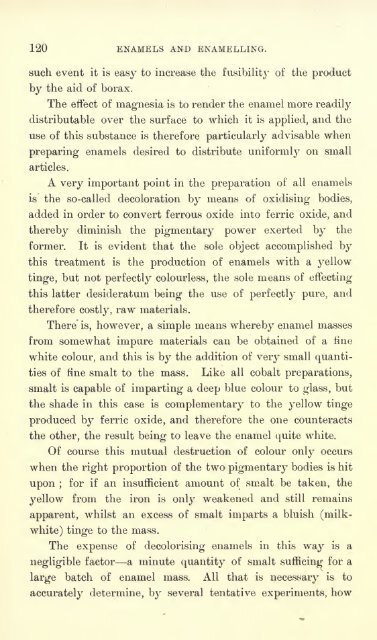Enamels and enamelling; an introduction to the preparation and ...
Enamels and enamelling; an introduction to the preparation and ...
Enamels and enamelling; an introduction to the preparation and ...
You also want an ePaper? Increase the reach of your titles
YUMPU automatically turns print PDFs into web optimized ePapers that Google loves.
120 ENAMELS AND ENAMELLING.<br />
such event it is easy <strong>to</strong> increase <strong>the</strong> fusibility of <strong>the</strong> product<br />
by <strong>the</strong> aid of borax.<br />
The effect of magnesia is <strong>to</strong> render <strong>the</strong> enamel more readily<br />
distributable over <strong>the</strong> surface <strong>to</strong> which it is applied, <strong><strong>an</strong>d</strong> <strong>the</strong><br />
use of this subst<strong>an</strong>ce is <strong>the</strong>refore particularly advisable when<br />
preparing enamels desired <strong>to</strong> distribute uniformly<br />
on small<br />
articles.<br />
A very import<strong>an</strong>t point in <strong>the</strong> <strong>preparation</strong> of all enamels<br />
is <strong>the</strong> so-called decoloration by me<strong>an</strong>s of oxidising bodies,<br />
added in order <strong>to</strong> convert ferrous oxide in<strong>to</strong> ferric oxide, <strong><strong>an</strong>d</strong><br />
<strong>the</strong>reby diminish <strong>the</strong> pigmentary power exerted by <strong>the</strong><br />
former. It is evident that <strong>the</strong> sole object accomplished by<br />
this treatment is <strong>the</strong> production of enamels with a yellow<br />
tinge, but not perfectly colourless, <strong>the</strong> sole me<strong>an</strong>s of effecting<br />
this latter desideratum being <strong>the</strong> use of perfectly pure, <strong><strong>an</strong>d</strong><br />
<strong>the</strong>refore costly, raw materials.<br />
There is, however, a simple me<strong>an</strong>s whereby enamel masses<br />
from somewhat impure materials c<strong>an</strong> be obtained of a fine<br />
white colour, <strong><strong>an</strong>d</strong> this is by <strong>the</strong> addition of very small qu<strong>an</strong>ti-<br />
ties of fine smalt <strong>to</strong> <strong>the</strong> mass. Like all cobalt <strong>preparation</strong>s,<br />
smalt is capable of imparting a deep blue colour <strong>to</strong> glass, but<br />
<strong>the</strong> shade in this case is complementary <strong>to</strong> <strong>the</strong> yellow tinge<br />
produced by ferric oxide, <strong><strong>an</strong>d</strong> <strong>the</strong>refore <strong>the</strong> one counteracts<br />
<strong>the</strong> o<strong>the</strong>r, <strong>the</strong> result being <strong>to</strong> leave <strong>the</strong> enamel quite white.<br />
Of course this mutual destruction of colour only occurs<br />
when <strong>the</strong> right proportion of <strong>the</strong> two pigmentary bodies is hit<br />
upon ;<br />
for if <strong>an</strong> insufficient amount of smalt be taken, <strong>the</strong><br />
yellow from <strong>the</strong> iron is only<br />
weakened <strong><strong>an</strong>d</strong> still remains<br />
apparent, whilst <strong>an</strong> excess of smalt imparts a bluish (milkwhite)<br />
tinge <strong>to</strong> <strong>the</strong> mass.<br />
The expense of decolorising enamels in this way is a<br />
negligible fac<strong>to</strong>r a minute qu<strong>an</strong>tity of smalt sufficing for a<br />
large batch of enamel mass. All that is necessary<br />
is <strong>to</strong><br />
accurately determine, by several tentative experiments, how
















